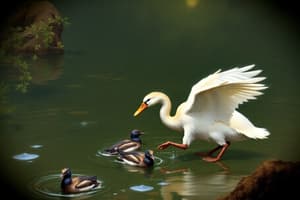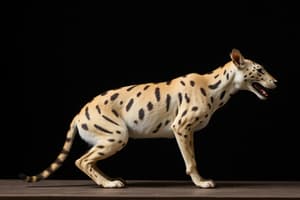Podcast
Questions and Answers
What characterizes innate behavior in animals?
What characterizes innate behavior in animals?
- Learned through experience
- Influenced by social interactions
- Acquired through conditioning
- Instinctual and developmentally fixed (correct)
Which of the following is an example of operant conditioning?
Which of the following is an example of operant conditioning?
- A bird learning to sing a song from its parents
- A dog salivating when it hears a bell
- A young animal recognizing its parent during a critical period
- A child receiving a reward for completing a task (correct)
Which of the following best describes social hierarchies in animal behavior?
Which of the following best describes social hierarchies in animal behavior?
- Establishing dominance relationships within groups (correct)
- Communicating through body language
- Defending territory against others
- Living in communal groups for protection
What is the primary focus of foraging behavior in animals?
What is the primary focus of foraging behavior in animals?
Which method of communication involves the use of scents?
Which method of communication involves the use of scents?
What behavior primarily occurs during a critical period in young animals?
What behavior primarily occurs during a critical period in young animals?
What factor is NOT typically associated with an animal's behavior?
What factor is NOT typically associated with an animal's behavior?
Which of the following is true about mating behavior in animals?
Which of the following is true about mating behavior in animals?
Flashcards are hidden until you start studying
Study Notes
Animal Behavior
-
Definition: Study of how animals interact with their environment and each other, encompassing instinctual and learned behaviors.
-
Types of Behaviors:
-
Innate Behavior:
- Instinctual and developmentally fixed
- Examples: reflexes, fixed action patterns (e.g., nesting behavior, migration)
-
Learned Behavior:
- Acquired through experience
- Types include:
- Habituation: Decreased response to a repeated, non-threatening stimulus.
- Classical Conditioning: Learning through association (e.g., Pavlov's dogs).
- Operant Conditioning: Learning through rewards and punishments.
- Imprinting: Specific attachment behavior occurring at a critical period (e.g., young birds recognizing parent).
-
-
Social Behavior:
- Study of interactions among individuals within a species.
- Types:
- Communal: Living in groups for protection or hunting.
- Territoriality: Defending a territory against others to secure resources.
- Social Hierarchies: Establishing dominance relationships within groups.
-
Communication:
- Various methods used by animals to convey information.
- Types:
- Vocal: Calls, songs, and sounds (e.g., bird songs, whale calls).
- Visual: Body language, colors, and displays (e.g., peacock feathers).
- Chemical: Scent marking, pheromones (e.g., ants, bees).
- Tactile: Touch communication (e.g., grooming in primates).
-
Foraging Behavior:
- Strategies animals use to locate and acquire food.
- Influenced by:
- Resource availability
- Competition
- Energy expenditure vs. reward
-
Mating Behavior:
- Courtship rituals and reproductive strategies.
- Types:
- Monogamy: One male and one female pair bond.
- Polygamy: One individual mates with multiple partners.
- Sexual Selection: Traits that evolve to attract mates.
-
Parenting Behavior:
- Caregiving strategies after offspring are born.
- Varies by species:
- Maternal care (e.g., mammals)
- In some species, males participate in nurturing (e.g., seahorses).
-
Migration and Movement:
- Seasonal movement of animals from one region to another.
- Influences:
- Breeding
- Food availability
- Climate
-
Factors Influencing Behavior:
- Genetics: Hereditary influences and evolutionary pressures.
- Environment: Physical surroundings and ecological factors.
- Learning: Experiences that alter behavior over time.
- Social structures: Group dynamics and cultural influences.
-
Ethology: Scientific study of animal behavior, emphasizing natural environments and observational techniques.
Understanding these aspects of animal behavior provides insights into ecological interactions, evolutionary processes, and species survival strategies.
Animal Behavior: An Overview
- Definition: The study of how animals interact with their environment and each other. This includes both instinctive and learned behaviors.
Types of Behaviors
- Innate Behavior: Instinctive and genetically determined. Examples include:
- Reflexes: Automatic responses to stimuli
- Fixed Action Patterns: Unchanging behavioral sequences triggered by specific stimuli (e.g., nesting birds, migrating animals)
- Learned Behavior: Acquired through experience. Types include:
- Habituation: Decreased response to a repeated, non-threatening stimuli.
- Classical Conditioning: Learning through association (Pavlov's dogs)
- Operant Conditioning: Learning through rewards or punishments (e.g., training a dog to sit).
- Imprinting: Specific attachment behavior occurring within a critical period (e.g., young birds recognizing their parents).
Social Behavior
- Communal Living: Individuals live together for protection, hunting, or other social activities.
- Territoriality: Defending an area for exclusive resource access.
- Social Hierarchies: Establishment of dominance relationships within groups.
Communication
- Vocal Communication: Animals use calls, songs, or sounds to convey information (e.g., bird songs, whale calls).
- Visual Communication: Body language, colors, and specific displays (e.g., peacock feathers).
- Chemical Communication: Scents, pheromones (e.g., ants, bees).
- Tactile Communication: Touch (e.g., grooming in primates).
Foraging Behavior
- Includes strategies animals use to locate and acquire food.
- Influenced by:
- Resource availability
- Competition from other animals
- The balance between energy expended and reward obtained.
Mating Behavior
- Includes courtship rituals and reproductive strategies.
- Types:
- Monogamy: One male and one female pair bond.
- Polygamy: An individual mates with multiple partners.
- Sexual Selection: Traits evolve to attract mates.
Parenting Behavior
- Caregiving strategies after offspring are born.
- Variations: Maternal care (mammals), in some species, males participate in nurturing (seahorses).
Migration and Movement
- Seasonal movement of animals from one region to another.
- Influenced by:
- Breeding requirements
- Food availability
- Climate
Factors Influencing Behavior
- Genetics: Hereditary influences and evolutionary pressures.
- Environment: Physical surroundings and ecological factors.
- Learning: Experiences that alter behavior over time.
- Social Structures: Group dynamics and cultural influences.
Ethology
- The scientific study of animal behavior, emphasizing natural environments and observational techniques.
- Understanding animal behavior provides insights into ecological interactions, evolutionary processes, and species survival strategies.
Studying That Suits You
Use AI to generate personalized quizzes and flashcards to suit your learning preferences.





